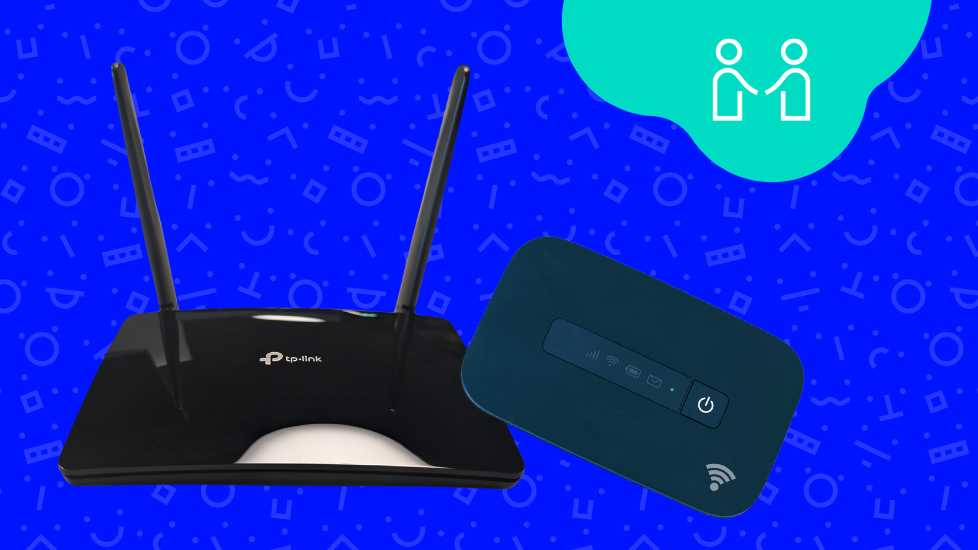Mobile internet for everyone and everything
5G Router in Test: The Acer Predator X5
5G Speed in Your Home – Gaming Features Included!
The range of cellular routers is growing year by year, and with the Acer Predator X5 we recently added a product to our store that combines the benefits of a 5G connection with a whole range of cool new features. The device is clearly geared towards online gaming, and as such, it delivers performance that can easily handle all other home application areas. We’ve tested the 5G Powerhouse for you and were pleased to discover: A lot has changed in 5G routers!
Hardware – Connections up to the Hilt
Compared to mobile 5G routers like the Nighthawk M5 from our store, the Acer Predator X5 is much bigger. The router measures 26.7×12.2x11cm and weighs 1.13kg. The black plastic case makes a stable impression and reminds us of typical gaming products like Razer. The Predator X5 is a home router, so it doesn’t have a battery and has to be permanently powered from a wall socket. The power button is on the front, as well as 4 status LEDs. The SIM card slot is located at the bottom of the case, next to a recessed reset button.

The back of the case is particularly interesting. Here we find a USB-A port for data media, three(!) Ethernet ports, a WPS button, as well as two TS-9 ports for external antennas besides the port for the included power supply. The Ethernet ports fulfill different functions depending on the requirements: The lowest one (gray) is an ordinary LAN port and the middle one (blue) serves as a dedicated gaming port and can be prioritized via router management to achieve the highest possible bandwidth. The upper port (gray “WAN”) can either be used as an additional LAN port or to connect to a wide area network (WAN for short). If the WAN port is also used in addition to 5G, the router can either distribute the connection load over both channels (“load-balance” option) or use one of the channels as a fallback in the event of a connection interruption of the primary channel (“failover” option).
Connectivity – 5G and WI-Fi 6 for Top Speed and Stability
A Mediatek T750 quad-core processor clocked at 2 GHz works inside the casing. According to the manufacturer, the fast 7nm chipset enables a data throughput of up to 4.7 Gbit/s and supports both 5G and 4G LTE. The fast processor and the current WiFi standard allow up to 256 devices to connect to the Predator X5 at the same time, which means that every device from e-sports events to open-plan offices should find access. Basically, all devices that support the following Wi-Fi frequencies are compatible:
2.4GHz (802.11 b/g/n/ax)
5GHz (802.11 a/n/ac/ax)
As with all cellular routers, the Predator X5’s effective download speed depends on the local network coverage and the router’s location. However, the built-in internal antenna manages a good reception even in suboptimal places, such as a bookshelf.

The WLAN’s range is particularly convincing. In the test apartment, the 5 GHz connection reached the garden border of the property as well as one floor above and below the router’s location. Thus, the range of the Predator X5 should be sufficient for most home applications and provide a medium-sized house with connectivity even without repeaters.
Application – Rich in Features Yet Simple
Setting up the network remains a breeze with the Predator X5, as with most cellular routers. Insert the active SIM card, turn it on, and you’re done!
The router’s default password is on a sticker at the bottom of the case and the connection worked smoothly with all devices in the test. That should be enough for many users, but the super-simple setup is complemented by numerous features that need to be discovered:
- Graphical interface for managing the router
Accessible via the address http://connect.acer and on any browser, the router home page allows convenient setting of all the router’s functions.
- Intel Killer Prioritization Engine
Enables detection and acceleration of traffic for specific websites or programs (for example, online games) by prioritizing them ahead of other connected devices.
- 5G + WAN Dual Connectivity
Allows for the greatest possible connection security through connection redundancy (failover) and a strong reduction in ping and latency.
- Integrated Trend Micro Home Security Engine
Strong router firewall for blocking malicious websites, network attacks or as parental control.
In addition to the router homepage, there is also a mobile app for iOS and Android that allows convenient network management directly from the smartphone. Acer thus offers a complete package for all eventualities, which should be very popular especially for gaming or in larger households.
Would You Like the Complete Solution Right Away?
We love smart devices, which is why we offer the Acer Predator X5 directly as a router bundle in our store. With Flat 300 and 5G, you can surf for a whole year at 300 Mbits and have everything under control in terms of cellular connectivity thanks to your personal customer portal. So things have really changed on the 5G router market. Gone are the days of fiddly mini-routers with weak range. The modern devices offer all the comfort that a common router would otherwise offer and additionally expand the experience with independence and a speed that can even satisfy the gaming scene. A clear no-brainer for us!
Besides the Acer Predator, we also offer other routers directly with the matching data plan, mobile with battery or wired. You can find an overview of all our router bundles here.
Discover Our Other News Articles

What Are Mbits and How Many Does a Cell Phone Need?
Whether it’s your home internet or your cell phone plan, Mbits are being talked about almost all the time. It’s clear that Mbits are supposed to indicate the speed of your internet connection. But what the numbers actually mean is not always clear. Does the principle of “the more, the better” apply? Or is there an ideal speed for smartphones?

Router vs. Hotspot: What’s the Difference?
If you want to connect to the internet, you usually do so via a router or hotspot. Both are sold as separate devices, and there is sometimes a lot of confusion when it comes to finding the right device for your needs. We want to clarify the terminology and tell you what distinguishes a router from a hotspot.

Tablet or Laptop? What’s Best for You?
Tablets have been acceptable as primary computers since the introduction of the iPad Pro, at the latest. Students have appreciated the light weight and flexibility of tablets for lecture notes for quite some time, but laptops have usually been the primary devices. Whether or not a tablet is the better choice as a main computer for you depends on your requirements and habits. To help you decide, we have summarized the strengths and weaknesses of the device types for you.
